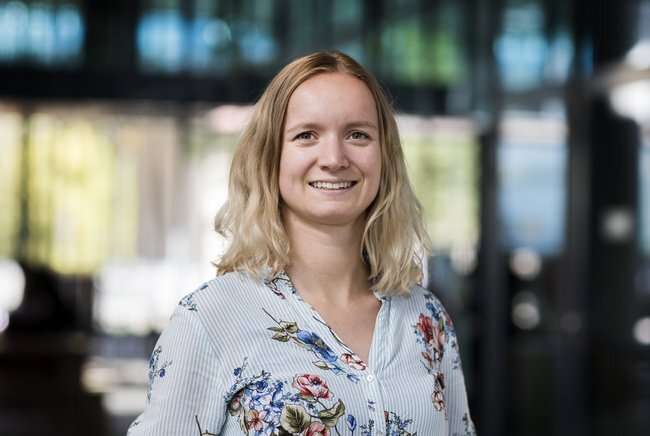Iris van de Gevel. Credit: Eindhoven University of Technology
Proteins are like machines. For some diseases, it can be useful to turn these machine off or on when they are too active or not active enough. One way to control switching in a protein, such as a nuclear receptor, is to put a drug "in the pocket" of the drug. For her Ph.D. research, Iris van de Gevel looked at controlling two receptors: RORγt, a receptor that is overactive in autoimmune diseases like rheumatoid arthritis and psoriasis, and PPARγ, a receptor that plays an important role in type 2 diabetes.
As nuclear receptors are so similar, they all have a similar pocket in the core of the protein. To make sure that a drug ends up in the pocket of the correct protein, it can be useful to understand how that pocket works, what makes it unique, and if there might be an alternative pocket. During her Ph.D. research, Iris van de Gevel tried to answer these questions by engineering proteins and developing novel assay formats.
Finding an alternative pocket
Van de Gevel worked on finding an alternative pocket in RORγt. This pocket was discovered by chance and seems to be unique within the nuclear receptor superfamily. This means that when you are able to develop successful drugs that fit this pocket, the chances are very slim that this drug also affects other receptors.
To figure out if this pocket was really unique, Van de Gevel studied the pocket in detail. From this research, she concluded that the combination of two absolute requirements to form this pocket is unique for RORγt within the entire nuclear receptor superfamily. This provides extra motivation to develop medicines for this pocket for the treatment of autoimmune diseases.
Binding to another receptor
Along with her collaborators in the Chemical Biology group, Van de Gevel also looked at how a molecule that is designed for the unique, alternative pocket of RORγt still happens to bind to another nuclear receptor: PPARγ.
Results from experiments with PPARγ show that the molecule binds at a completely different spot than it does in RORγt, and that small alterations have an effect on the preference for either RORγt or PPARγ. This showed that it is possible to obtain a larger selectivity for one of these proteins, and paves the way towards the creation of even more specific molecules in the future.
At the same time, the molecule appears to have a novel binding mode that could be very advantageous. This makes it very interesting to develop similar, optimized molecules for PPARγ for the treatment of type 2 diabetes.
Novel assay
Finally, Van de Gevel also developed a novel assay format. In the first stages of drug development, it is very important to have an idea about how strong a molecule binds within the pocket of a receptor. There is a range of methods available that could measure this, but each of them have disadvantages
To solve this, Van de Gevel developed an assay that can measure binding affinities in a cheap, label-free manner without the need for extensive optimization and using standard equipment, making it possible to perform this in any lab. In short, this assay uses the difference in melting temperature of protein with or without a filled pocket. By measuring the amount of protein that is still intact after being heated, it's possible to deduce how strong a molecule binds to the protein.
More information: Understanding Allosteric Modulation of Nuclear Receptors by Engineering Proteins and Assays. research.tue.nl/en/publication … r-receptors-by-engin
Provided by Eindhoven University of Technology
























